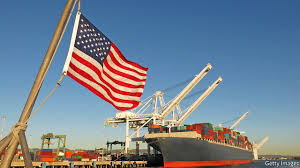A trade war between America and China takes shape

TALK of tariffs is in danger of developing into cries of trade war. On April 3rd America published a list of some 1,300 Chinese products it proposes to hit with tariffs of 25%. Just a day later China produced its own list, covering 106 categories. “As the Chinese saying goes, it is only polite to reciprocate,” said the Chinese embassy in Washington, DC.
According to the Peterson Institute for International Economics, a think-tank, America’s list covers Chinese products worth $ 46bn in 2017 (9% of that year’s total goods exports to America; see graphic). China’s covers American goods worth around $ 50bn in 2017 (38% of exports). The sums were enough to move markets on April 4th, though the S&P 500 index soon made up lost ground.
Get our daily newsletter
Upgrade your inbox and get our Daily Dispatch and Editor’s Picks.
Both countries’ lists are, for now, no more than threats. Over the next two months America’s list will be open for public consultation (there is no deadline for the tariffs to come into force). China has said that it will wait for America to move. There is still a chance the two sides will choose a deal over a trade war. Although America’s list was drawn up in response to China’s alleged theft of American firms’ intellectual property, Mr Trump regards the trade deficit with China as a separate affront. Tariffs might yet be avoided by China agreeing to buy more American stuff.
But this skirmish follows others. On March 23rd America imposed tariffs on steel and aluminium from some countries, including China. That prompted tariffs covering around $ 3bn of American exports to China. More retaliation is expected, as the Chinese react to separate American tariffs on solar panels and washing machines.
Historians of trade have an advantage over those who study wars of the military kind. Each side in a trade dispute lays out in detail the products to be affected. That makes it easier to analyse their strategies.
Mr Trump’s tariffs on steel and aluminium turn out to be rather crude. They are an attempt to protect a single industry by blocking foreign competition, guided by a mistaken belief that this will make it stronger. By contrast, China’s retaliation, and the latest American threats over intellectual property, are more sophisticated. Rather than coddling one industry, they are meant to prod a trading partner into changing its behaviour. They are means, not ends.
This week’s American list is designed to hit products benefiting from China’s industrial policy, including its “Made in China 2025” plan to dominate certain strategic sectors. Industrial robots, motors for electric vehicles and semiconductors are all in its sights. (At least 90 products, including aircraft parts and cars, recorded no Chinese exports to America in 2017 and may be intended as a pre-emptive strike.)
That might seem fair in Mr Trump’s eyes. But bureaucrats crafting trade-protection policy face a trade-off between punching the other country and protecting their own consumers. Even before the latest announcement, some offending products had been dropped from America’s list after government analysts identified them as “likely to cause disruptions to the US economy”, or “subject to legal or administrative constraints”. The final choice took account of the availability of substitutes from elsewhere. Analysts at Goldman Sachs, a bank, estimate that of the products proposed for tariffs, only around 20% of America’s imports in 2017 came from China (the share is higher for LEDs, televisions, and printers and copiers).
The element of surprise
Some parts of America’s strategy were unexpected. Minimising disruption to businesses would suggest tariffs on finished goods rather than their inputs. Some companies may not realise that their suppliers are buying from China, so higher costs for intermediate goods could travel along supply chains in unpredictable ways. Pricier parts could make American manufacturers less competitive than foreign rivals. However, although the two biggest tariff lines by value on America’s list were colour-screen televisions and passenger vehicles, consumer products accounted for less than 20% of the affected imports.
What of China? In response to America’s tariffs on steel and aluminium, it placed tariffs on $ 0.2bn-worth of iron and steel tubes, pipes and hollow profiles, and $ 1.2bn-worth of aluminium waste. This echoed Canada’s response to the American Smoot-Hawley tariff of 1930, when it raised tariffs on eggs as retaliation for America doing the same. Douglas Irwin of Dartmouth College reports that the number of eggs Canada exported to America fell by 40% between 1929 and 1932. But the number going the other way plunged by 99%. Such tit-for-tat retaliation is intended to demonstrate that trade barriers make industries weaker, not stronger.
The list China published on April 4th is even bolder. It makes no effort to comply with World Trade Organisation rules, and aims at pressure points in America’s democracy, including industries with powerful lobbies, such as aircraft and soyabeans, as well as products from politically sensitive states. Wisconsin is home both to Paul Ryan, the Speaker of the House of Representatives, and a sizeable share of America’s cranberry exporters. Mitch McConnell, the Republican leader of the Senate, represents Kentucky, home to America’s bourbon exporters. Both products are included in China’s $ 50bn tariff threat.
Such methods have worked before. In 2003, when the European Union threatened to put tariffs on American products, including oranges, in retaliation for George W. Bush’s tariffs on European steel, Mr Bush yielded. (Florida, a crucial swing state, is home to many orange-growers.) Mr Trump’s pronouncements do not suggest he is ready to sue for peace. Nor does he seem aware of the risks of failure.
This article appeared in the Finance and economics section of the print edition under the headline “Blow for blow”
